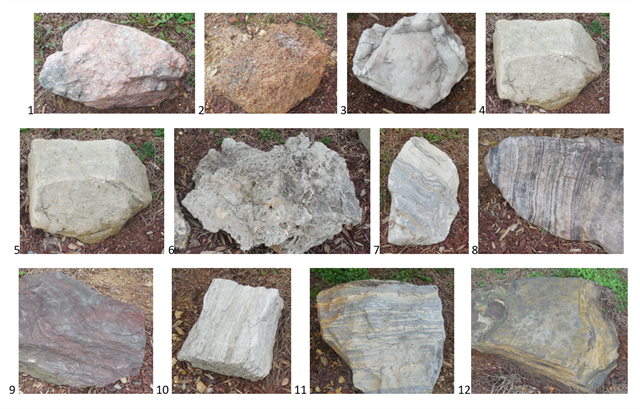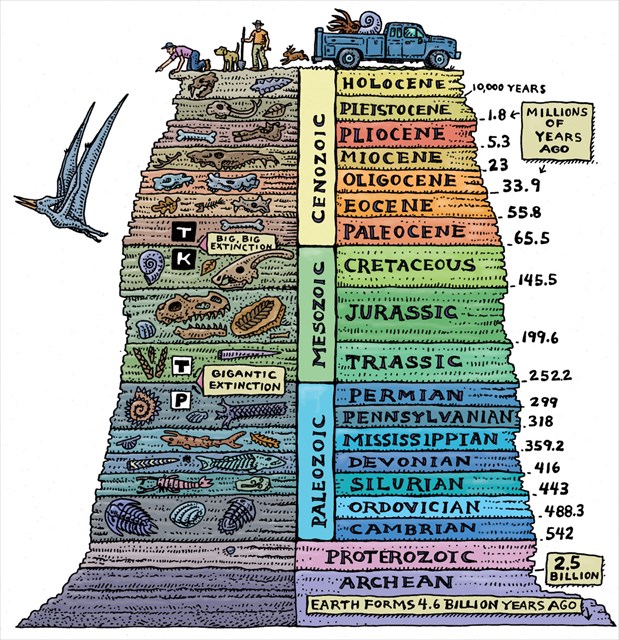EARTHCACHE REQUIREMENTS
Each cacher must send his/her own answers BEFORE logging a find. Enjoy the journey (learning adventure) as well as the destination (smiley earned). Remember to take only pictures and leave only footprints. To get credit for this Earthcache, complete the following tasks:
The rock garden contains rocks from Tennessee and the surrounding areas. The signs give the information needed to answer the questions. The rocks pictured are the ones from Tennessee.
1. MESSAGE …. a. Identify each of the pictured rocks by name. ... b. Group them by type (sedimentary/igneous/metamorphic).
2. MESSAGE …. a. Place each rock along the geologic time line according to when they were formed beginning with the Neoproterozoic (oldest) and ending with the Mississippian (youngest). ... What era and period are most of the rocks from? Use your data and the chart to answer this question. EXAMPLE Cenozoic Holocene
3. LOG …. Post a picture at or near the coordinates. This picture is your log signature.
OPTIONAL - Please respect the time and effort involved in creating this earthcache by adding A and B to your log.
A. JOURNEY OF THE MIND ... Science explains what we observe. Relate (in your own words) something you found interesting in the reading. This adds to your learning adventure and your log.
B. JOURNEY OF THE HEART ... Art shares our personal experience of what we see. Share something special you found on site, and why it is special to you. This is a memorable addition to your log and will make other hearts smile.
Journeys of Heart and Mind ...
Stories to Touch the Heart and Puzzles to Challenge the Mind / Rainbow Tree Story
C. Visit the dig site and museum. Compare the era and period the rocks are from with the era and period the fossils are from.
BONUS: There are two earthcaches here - GC1554M and GC700MR.
THANK YOU Chris Widga (Head Curator) for permission to share this learning adventure.


SEDIMENTARY ROCKS (formed by weathering)
Sedimentary rocks form from small weathered particles of other rocks or the weathered shells of sea animals. Wind and rain beating on the faces of exposed rock wear off particles that are blown or washed to a new location. When sea creatures die, the shells settle on the bottom of the ocean. As the sediments pile up, they press together to form sedimentary rock.
Sedimentary rocks are the predominant rocks found throughout Tennessee. Limestone (Calcium carbonate) found just about everywhere in Tennessee, was declared the official state rock in 1979. Limestone is most abundant through middle Tennessee and is found in scattered areas through eastern Tennessee. Tennessee marble (metamorphic version of limestone) is widely used in public and private buildings.
In Tennessee, and in much of eastern North America, calcium carbonate sediment accumulated in the warm, shallow continental seas and eventually compacted into limestone. Then, around 300 million years ago, the continents began to converge into the supercontinent Pangaea. The force of the long, slow collision between Africa and North America buckled most of eastern North America into a long, folded ridge, the Appalachians. The Ordovician limestones in eastern Tennessee were pushed into long, narrow, northeast-southwest folds.
IGNEOUS ROCKS (formed from fiery molten magma)
Igneous rocks are formed from magma, the molten form of the earth’s mantle layer. Igneous rocks can form above ground as lava spewing from volcanoes. Igneous rocks can also form below the surface. Pockets of magma get stuck in layers of the earth. As they get closer and closer to the surface, the magma slowly cools.
Intrusive Igneous Rocks are found in Union County and Sevier County. Mica peridotite plugs intrude Sneedville Limestone in Union County. Metadiorite and metagabbro sills and dikes intrude Great Smoky Group in Sevier County.
METAMORPHIC ROCKS (formed under intense heat and pressure)
Metamorphic rocks form under intense heat and pressure. Metamorphic rocks start out as igneous rocks, sedimentary rocks or other types of metamorphic rocks. Through heat and/or pressure, the rocks change characteristics such as sheen, tightness of grain and hardness.
Metamorphosed sedimentary rocks are the dominant rock types in the Great Smoky Mountains National Park. Rocks become metamorphosed when they are subjected to heat and pressure, usually related to mountain building. Metamorphosed sandstone, siltstone, and shale, are most common in the park. Throughout the Smokies, large boulders of metamorphosed sandstone are common in streams. The rocks fall from cliff outcrops, eventually make their way into the streams, are carried downstream, rounded, and then eventually broken down into cobbles, pebbles, sand, and silt.
TENNESSEE ROCKS OVER TIME

The Neoproterozoic Era is the last era of the Proterozoic Eon.
The Phanerozoic Eon is subdivided into three eras and multiple periods.
RESOURCES
http://www.ereferencedesk.com/resources/state-symbols/tennessee/rock.html
https://mrdata.usgs.gov/geology/state/sgmc-unit.php?unit=TNig%3B15
https://www.nps.gov/grsm/learn/nature/geology.htm#10/35.6400/-83.5764